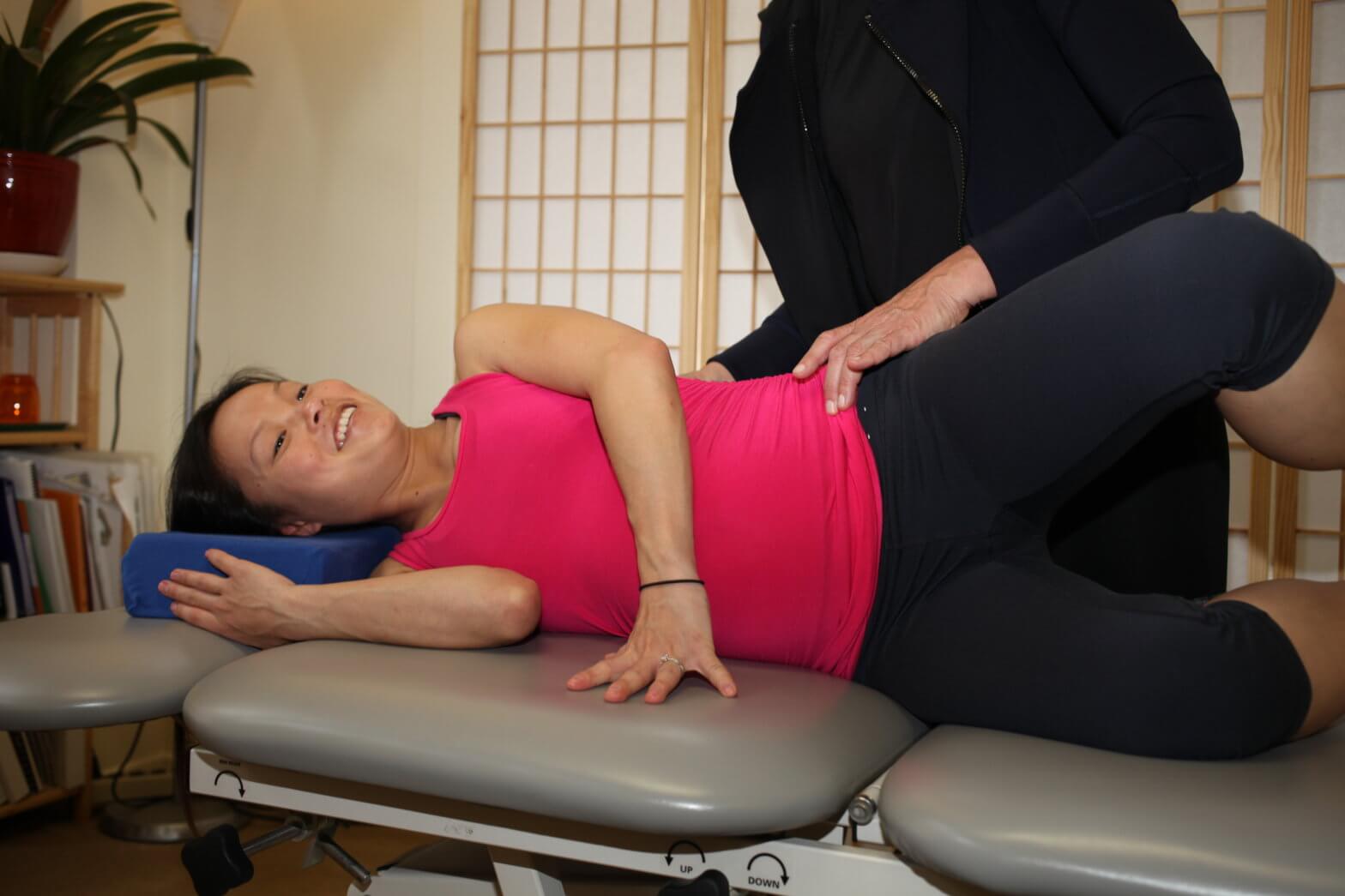Pelvic Pain Relief
Pelvic pain can occur for a number of reasons. This type of pain can be limiting and, for some people, even a bit embarrassing. It can hinder your daily life and prevent you from doing some of your daily tasks or activities you love. Fortunately, pelvic floor rehabilitation can help ease your symptoms of pelvic dysfunction and strengthen your pelvic floor muscles so you don’t experience additional problems in the future. If you are experiencing pelvic pain, contact Rising Sun Physical Therapy San Francisco today to find relief!
What is the Pelvic Floor?
The pelvic floor is a sheet of muscles, ligaments, nerves, and connective tissues that passes through the “floor” of the pelvis and supports the bladder, rectum, and other organs within the pelvic area. Both women and men have a pelvic floor.
The function of the pelvic floor is very important as it supports some of the body’s vital organs and helps with the maintenance and self control of the urinary and anal sphincters. It has a big role in women during pregnancy and birth, as it helps the fetus to rotate forwards and navigate through the pelvic girdle.
More women than men have issues with their pelvic floor one or more times in their life. And nearly half of all women will experience some sort of pelvic floor dysfunction.
What are Pelvic Floor dysfunctions?
Pelvic floor dysfunctions occur when the muscles in the pelvic floor supporting the pelvic organs become weak, tight, or damaged. Some of the main problems with pelvic floor dysfunction include lack of bladder control, lack of bowel control, and/or pelvic organ prolapse. Many of these conditions can be uncomfortable and cause pain in the pelvic region.
A deeper conversation can illuminate urinary and bowel irregularities, pain or pressure in the vagina or rectum, the feeling of a heavy pelvis, muscle spasms, and/or pain or discomfort with sexual intercourse. It is important to talk with your health care providers about these problems as it is common for pelvic floor dysfunction to go avoided or ignored.
You may feel like you are the only one in this situation, but urinary incontinence affects 25 million adult Americans. 26% of women between 18 and 59 have involuntary leakage, 1 of 7 American women ages 18 to 50 have pelvic pain, and 61% go without diagnoses!
Pelvic floor dysfunction can be caused by a number of specific conditions. These conditions may be due to pregnancy or childbirth, insidious onset, infections, poor posture from chronic low back or SI dysfunction, trauma (e.g. injury from falling), or even the result of surgery. Some disorders include, but are not limited to, disorders of the bladder (e.g. IC, Prostatitis, Prostatodynia), disorders of the bowel (IBS, abdominal pain, pressure, discomfort, and bloating), sexual dysfunctions, pelvic dysfunction, or post surgical issues.
How does physical therapy help pelvic pain?
Physical therapy treatments, such as pelvic floor rehabilitation and accompanying methods, have been proven to treat a variety of conditions resulting in pelvic pain. Some of the most common pelvic conditions that physical therapy treats include:
Postpartum pelvic pain
After giving birth, it is common for new mothers to experience strained muscles and/or connective tissue damage in their pelvic floor. Pelvic floor rehabilitation helps in reducing the pain that is being felt, in addition to strengthening any damaged muscles or tissues.
Pain following abdominal surgery
If you are recovering from a recent surgical procedure, pelvic floor rehabilitation can help in breaking up scar tissue, improving strength, and regaining range of motion in your abdomen/pelvic region.
Endometriosis
Endometriosis can affect the bones, muscles, ligaments, and nerves in the pelvic region. Pelvic floor rehabilitation can help reduce the pain and bloating that you may be experiencing with endometriosis, in addition to strengthening the pelvic floor muscles.
Urinary incontinence
A physical therapist can help determine the root of your problem with urinary incontinence, rather than simply treating the symptoms. Pelvic floor rehabilitation will focus on strengthening the muscles under your bladder in order to treat and eliminate incontinence issues.
Constipation
Pelvic floor rehabilitation can loosen and relax the muscles in your pelvic and anal areas, which can help relieve and eliminate constipation.
While these are just a few of the most common conditions of pelvic dysfunction that can be treated with physical therapy, there are a number of additional pelvic conditions that PT treatments can relieve. For example, painful intercourse and infertility problems may also be improved with pelvic therapy. Some less common conditions that can be treated also include pelvic organ prolapse, dyspareunia, and diastasis recti.
How can physical therapy aid pelvic pain relief?
The muscles, tendons, and ligaments that comprise the pelvic floor all serve an extremely important purpose, as they support the core of your body. One of our highly trained downtown San Francisco physical therapists can help in relieving your pelvic pain, improving your flexibility, and increasing your overall functionality.
There is help beyond Kegel exercises and pads that hide symptoms as opposed to healing them. Our Pelvic Floor Physical Therapy program helps to relieve symptoms, discomfort, and embarrassment. Because our therapists have years of experience with evaluating and treating pelvic floor dysfunctions, we not only address the issue, but help you on the road to recovery.
Some things you can expect from an evaluation and treatment with us:
- We review your medical history thoroughly
- We will perform a general orthopedic evaluation and, when necessary, an internal pelvic
- floor exam to help identify the source of your problem
- A specific treatment plan is created and tailored to your needs upon the findings in the
- examination. This may include custom exercises, muscle reeducation, postural and habit
- retraining, education, nutrition counsel, and more.
- The tools we have most effectively used are a variety of manual therapies. Including
- biofeedback, muscle reeducation techniques, and applied Pilates type exercises.
The treatments involved in your pelvic floor rehabilitation plan will be dependent upon the results of your initial assessment. Your injury or condition will be evaluated during a physical examination, and then a qualified physical therapist will form a treatment plan that will address your specific needs. This will typically include several forms of exercise to reduce pain, lessen symptoms, and potentially heal your condition.
Our San Francisco, CA physical therapy office is equipped with the resources necessary for treating all forms of pelvic pain. In many cases, our treatment methods can help provide pelvic pain relief and recovery for problems that patients have been facing for years. If your pain is limiting you, contact Rising Sun Physical Therapy today to begin your path toward long-lasting relief!



